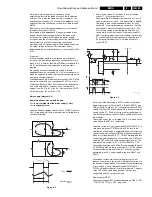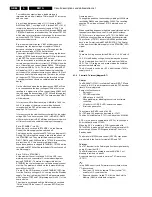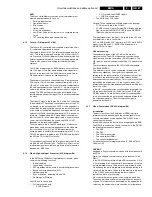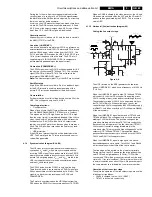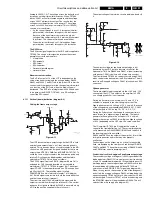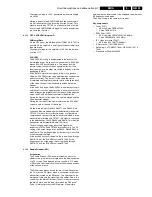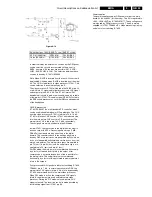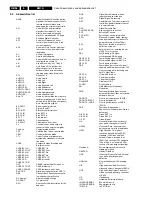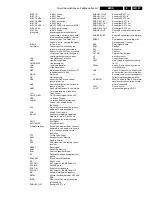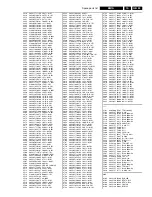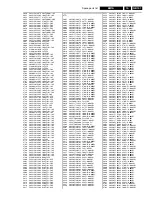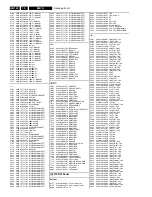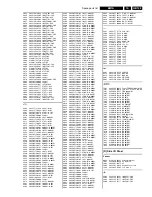
Circuit descriptions and abbreviation list
GB 93
EM1A
9.
The supply voltage is +28 V, generated by the main supply
via L5506.
Muting is done via the SOUND-ENABLE line connected to
pin 2 of the amplifier-IC and coming from the Painter. This
signal is inverted by TS7730, as a result of which at a high
level of the SOUND-ENABLE signal, current is sinked from
pin 2 and the IC mutes.
9.1.13 CRT & SCAVEM (diagram F)
RGB amplifiers
On the CRT panel, the RGB amplifier (TDA6108, IC7307) is
located. Via the outputs 9, 8 and 7 the cathodes of the picture
tube are driven.
The supply voltage for the amplifier is 180 V and is derived
from the LOT.
SCAVEM
The SCAVEM-circuitry is implemented in the layout of the
picture tube panel. It is thus not an extra module. SCAVEM
means SCAn VElocity Modulation. This means that the
picture content influences the horizontal deflection. In an
ideal square wave, the sides are limited in slope by a limited
bandwidth (5 MHz).
SCAVEM will improve the slope as follows: At a positive
slope, an SCAVEM-current is generated which supports the
deflection current. The first half of the slope the spot is
accelerated and the picture is darker, while at the second half
of the slope, the spot is delayed and the slope becomes
steeper.
At the end of the slope, the SCAVEM-current decays to zero
and the spot is at the original position. An overshoot occurs
which improves the impression of sharpness. At the negative
slope, the SCAVEM-current counteracts the deflection.
During the first half of the slope, the spot is delayed and the
slope becomes steeper.
During the second half the spot accelerates, the SCAVEM-
current is zero at the end of the slope.
Via the three resistors R33315, R33317 and R3320, Red,
Green and Blue are added together and offered to the emitter
TS7300. On the collector of this transistor, configured in a
common base, the sum of these 3 signals is obtained. Via the
emitter follower formed with TS7301, this signal is conveyed
to the differentiator C2303, R3309 and R3318. Only the high
frequencies are differentiated (small RC-time).
The positive and negative pulses of this signal drive
respectively TS7303 and TS7302 into conductivity. The DC
setting of the output stage is set by R3304, R3308, R3316
and R3319. The working voltage of the transistors is settled
at half the supply voltage.
At the positive section of the pulse, the current flows through
R3318, C2307, the SCAVEM-coil and TS7303. At the
negative section of the pulse, the current flows through
R3318, C2409, the SCAVEM-coil and TS7302.
9.1.14 Double Window (DW)
Introduction
The Double Window (DW) panel provides the option for
viewer to see two pictures or programs on the displayed area
of a TV screen. The displayed pictures can be in PIP mode
or DW mode. The viewer can also select the size and position
of the 'second' picture.
The DW-models always have 2 tuners. In the AP execution,
the TV uses one RF signal, which is connected, to the tuner
with splitter located on the DW panel. The 2nd tuner on the
main panel is fed with the signal from this splitter. Due to this
connection, the Main PCB tuner (Tuner 1) always processes
the Main Picture, and the tuner located on the DW panel
(Tuner 2) always process the DW picture. If the picture
between the two tuners need to be swapped, then the tuner
RF frequency is swapped.
The AV-switching is the same for all regions.
Key components
•
Tuner (7201):
–
AP Non-China TEDE9X700A
–
China TEDE9X701A
•
SAW Filter (1352):
–
AP Non-China OFWK7260M (39.8MHz)
–
China OFWK6287K (38.0 MHz)
•
IF + Video processor (7301):
–
AP/China & LATAM TDA8889H
•
PIP processor (7801) SAB9081H
•
Switching IC's TDA8601 (7803), HEF4053 (7401 &
7402)
•
IO expander (7403) M62320P







